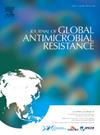The frequency of AmpC overproduction, OprD downregulation and OprM efflux pump expression in Pseudomonas aeruginosa: A comprehensive meta-analysis
IF 3.7
3区 医学
Q2 INFECTIOUS DISEASES
引用次数: 0
Abstract
Objectives
Pseudomonas aeruginosa is a major opportunistic pathogen responsible for a wide range of infections. The emergence of antibiotic resistance in this pathogen poses a significant public health challenge. This study aims to conduct a comprehensive meta-analysis of studies conducted in Iran to determine the frequency of key antibiotic resistance mechanisms in Pseudomonas aeruginosa and their association with multidrug-resistant and extensively drug-resistant strains or pandrug-resistant strains.
Methods
Systematic database searches encompassing literature up to June 2023 were undertaken. The selected studies centered on OprD downregulation, efflux pump (mexAB-OprM, mexXY-OprM) expression, and AmpC overproduction. Extracted data were synthesised in a meta-analysis for pooled frequency determination of each resistance mechanism.
Results
In total, 24 studies were included. OprD downregulation exhibited a pooled frequency of 61%. Efflux pump component frequency ranged from 48% to 77.5%. AmpC overproduction was identified in 29.1% of isolates. Polymyxin B and colistin demonstrated lower antibiotic resistance rates, with pooled frequency of 1% and 1.6%, respectively. Conversely, resistance to other antibiotics ranged widely, with pooled frequency spanning 38.4% to 98.2%.
Conclusions
This study underscores the concerning frequency of diverse antibiotic resistance mechanisms in Pseudomonas aeruginosa strains from Iran. Concurrent OprD downregulation, mexAB, mexXY, OprM expression, and AmpC overproduction highlight the urgent need for stringent infection control and prudent antibiotic usage to curb the dissemination of these resistant strains.
PROSPERO
CRD42022379311
铜绿假单胞菌中 AmpC 过量产生、OprD 下调和 OprM 出流泵表达的频率:一项全面的 Meta 分析。
背景:铜绿假单胞菌是一种主要的机会性病原体,可导致多种感染。这种病原体出现的抗生素耐药性对公共卫生构成了重大挑战。本研究旨在对在伊朗进行的研究进行全面的荟萃分析,以确定铜绿假单胞菌主要抗生素耐药机制的频率及其与多重耐药菌株、广泛耐药菌株或泛耐药菌株的关联:对截至 2023 年 6 月的文献进行了系统的数据库检索。所选研究以 OprD 下调、外排泵(mexAB-OprM、mexXY-OprM)表达和 AmpC 过量产生为中心。对提取的数据进行荟萃分析,以确定每种抗药性机制的集合频率:结果:共纳入 24 项研究。OprD下调的集合频率为61%。外排泵成分的频率从 48% 到 77.5% 不等。29.1%的分离菌株发现了AmpC过量产生。多粘菌素 B 和秋水仙素的耐药率较低,分别为 1%和 1.6%。相反,对其他抗生素的耐药性范围很广,集合频率从 38.4% 到 98.2%:本研究强调了伊朗铜绿假单胞菌菌株中多种抗生素耐药机制的频率。同时出现的 OprD 下调、mexAB、mexXY、OprM 表达和 AmpC 过量产生突出表明,迫切需要进行严格的感染控制和谨慎使用抗生素,以遏制这些耐药菌株的传播:CRD42022379311。
本文章由计算机程序翻译,如有差异,请以英文原文为准。
求助全文
约1分钟内获得全文
求助全文
来源期刊

Journal of global antimicrobial resistance
INFECTIOUS DISEASES-PHARMACOLOGY & PHARMACY
CiteScore
8.70
自引率
2.20%
发文量
285
审稿时长
34 weeks
期刊介绍:
The Journal of Global Antimicrobial Resistance (JGAR) is a quarterly online journal run by an international Editorial Board that focuses on the global spread of antibiotic-resistant microbes.
JGAR is a dedicated journal for all professionals working in research, health care, the environment and animal infection control, aiming to track the resistance threat worldwide and provides a single voice devoted to antimicrobial resistance (AMR).
Featuring peer-reviewed and up to date research articles, reviews, short notes and hot topics JGAR covers the key topics related to antibacterial, antiviral, antifungal and antiparasitic resistance.
 求助内容:
求助内容: 应助结果提醒方式:
应助结果提醒方式:


